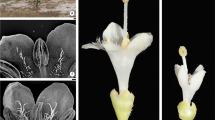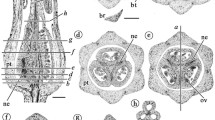Abstract
Different breeding systems occur in the Gardenieae complex (Rubiaceae), from homoecy to dioecy which is present in two tribes, Gardenieae and Cordiereae. As part of a broad project focused on the reproductive anatomy of the species of these two tribes, we described the structural and functional differences of the gynoecium in the different floral morphs and determined the degree of gynoecium development in the staminate flowers. We conducted a comparative anatomical study focused on the gynoecium of one homoecious species (Tocoyena formosa, with perfect flowers) and three dioecious species (Genipa americana, Randia calycina, and Randia heteromera) of Gardenieae and one dioecious species (Cordiera concolor) of Cordiereae. The dioecious species have flowers that are morphologically perfect and functionally unisexual. Flowers in successive stages of development were collected, photographed, and fixed in formalin-acetic acid-alcohol. The material was examined using light microscopy and scanning electron microscopy. The anatomy of the ovary, style, and stigma was analyzed, and megasporogenesis and megagametogenesis were studied. The results achieved in this study, together with previously obtained data of the androecium, show that dioecy originated from homoecy in these species, since the unisexual flowers conserve some characteristics of the perfect flowers. In addition, a new type of ovule for the Rubiaceae family is described.













Similar content being viewed by others
References
Andronova NN (1977) On the structure of the ovule of Rubiaceae. Bot Zeitung 62:1461–1469
Borges R, Razafimandimbison S, Roque N, Rydin C (2021) Phylogeny of the Neotropical element of the Randia clade (Gardenieae, Rubiaceae, Gentianales). Plant Ecology and Evolution 154(3):458–469. https://doi.org/10.5091/plecevo.2021.1889
de Candolle AP (1830) Prodromus systematis naturalis regni vegetabilis, vol 4. Treuttel & Würz, Paris. https://doi.org/10.5962/bhl.title.286
Castro CC, Oliveira PEAM, Pimentel RMM (2008) Reproductive biology of the herkogamous vine Chiococca alba (L.) Hitchc. (Rubiaceae) in the Atlantic Rain Forest, SE Brazil. Rev Brasil Bot 31(2):317–321
De Block P (1995) Ovary, seed and fruit of Rutidea (Rubiaceae, Pavetteae). Pl Syst Evol 196:1–17
De Block P, Igersheim A (2001) Stigma of the African Genera Rutidea and Nichallea (Rubiaceae-Ixoroideae-Pavetteae): highly modified receptive surfaces. Int J Pl Sc 162:567–578
De Toni KLG, Mariath JEA (2004) Desenvolvimento do rudimento seminal em Borreria verticillata (L.) G. Mey. (Rubiaceae – Rubioideae – Spermacoceae). Rev Brasil Bot 27:185–219
De Toni KLG, Mariath JEA (2008) Ovule ontogeny in Rubiaceae (Juss.): Chomelia obtusa (Cinchonoideae–Guettardeae) and Ixora coccinea (Ixoroideae–Ixoreae). Pl Syst Evol 272:39–48
De Toni KLG, Mariath JEA (2010) Ovule ontogeny of Relbunium species in the evolutionary context of Rubiaceae. Austral J Bot 58:70–79
Douglas GE (1957) The inferior ovary. Bot Rev 23:1–46
Endress PK (2011) Angiosperm ovules: diversity, development, evolution. Ann Bot 107:1465–1489
Fagerlind F (1937) Embryologische, zytologische und bestäubungsexperimentelle studien in der familie Rubiaceae nebst Bemerkugen über einige polyploiditätsprobleme. Acta Horti Berg 2:196–470
Figueiredo RC, Masullo FA, Vieira RC, De Toni KLG (2013a) Development of carpels and ovules in Psychotria carthagenensis (Psychotrieae) and Rudgea macrophylla (Palicoureeae) (Rubioideae, Rubiaceae). S African J Bot 84:110–114
Figueiredo RC, Vieira RC, De Toni KLG (2013b) Development of the gynoecium of Guettarda pohliana in the context of Rubiaceae evolution. Botany 91:562–567
Figueiredo RC, Vieira RC, Mariath JEA, Moço MCC, De Toni KLG (2017) Development of carpels and ovules in Dialypetalanthus fuscescens Kuhlm. (Rubiaceae): an enigmatic taxon. Acta Bot Bras 31:128–133
Florentin MN, Cabaña Fader A, Gonzalez AM (2016) Morpho-anatomical and morphometric studies of the floral structures of the distylous Oldenlandia salzmannii (Rubiaceae). Acta Bot Bras 30:585–601
Galati BG (1991) Estudios embriológicos en la tribu Spermacoceae (Rubiaceae). Parte 1: Anatomia floral. Megasporogénesis Megagametogénesis Bol Soc Argent Bot 27:7–20
Gonzalez AM, Cristóbal CL (1997) Anatomía y ontogenia de semillas de Helicteres lhotzkyana (Sterculiaceae). Bonplandia 9:287–294
Groeninckx I, Vrijdaghs A, Huysmans S, Smets E, Dessein S (2007) Floral Ontogeny of the Afro-Madagascan Genus Mitrasacmopsis with Comments on the Development of Superior Ovaries in Rubiaceae. Ann Bot 100:41–49
Hallé F (1967) Étude biologique et morphologique de la tribu des Gardéniées (Rubiacées). Mém ORSTOM 22:1–146
Heslop-Harrison Y, Shivanna KR (1977) The receptive surface of the angiosperm stigma. Ann Bot 41:1233–1258
Johansen DA (1940) Plant microtechnique. McGraw-Hill, New York
Johri BM (1984) Embryology of angiosperms. Springer-Verlag
Judkevich MD (2019) Anatomía reproductiva en especies de Cordiera, Genipa, Randia y Tocoyena (Gardenieae - Rubiaceae), doctoral thesis
Judkevich MD, Salas RM, Gonzalez AM (2020, in press) Anther structure and pollen development in species of Rubiaceae and anatomical evidence of pathway to morphological dioecy. An Acad Bras Ciênc
Li A, Wu X, Zhang D, Barrett S (2010) Cryptic dioecy in Mussaenda pubescens (Rubiaceae): a species with stigma-height dimorphism. Ann Bot 106:521–531
Lloyd FE (1899) The comparative embryology of the Rubiaceae. Mem Torrey Bot Club 8:1–112
Luque R, Sousa HC, Kraus JE (1996) Métodos de coloração de Roeser (1972) - modificado - de Kropp (1972) visando a substituição do azul de astra por azul de alcião 8 GS ou 8 GX. Acta Bot Bras 10:199–212
Maheswari Devi H, Krishnam Raju PVSNG (1980) Embryology of two species of Dentella (Dentella repens and Dentella serpyllifolia). Proc Indian Acad Sci (plant Sci) 89:213–218
Mariath JEA, Cocucci AE (1997) The ovules of Relbunium hypocarpium in the context of the Rubiaceae. Kurtziana 25:141–150
Mayer SS, Charlesworth D (1991) Cryptic dioecy in flowering plants. Trends Ecol Evol 6:320–325
Mouly A, Kainulainen K, Persson C, Davis AP, Wong KM, Razafimandimbison SG, Bremer B (2014) Phylogenetic structure and clade circumscriptions in the Gardenieae complex (Rubiaceae). Taxon 63:801–818
Naiki A (2008) Breeding system in Mussaenda shikokiana (Rubiaceae). Bull Am Mus Nat Hist 62:21–26
Naiki A, Kato M (1999) Pollination system and evolution of dioecy from distyly in Mussaenda parviflora (Rubiaceae). Plant Species Biol 14:217–227
Pacini E (1996) Reproductive strategies in dioecious plants. Giorn Bot Ital 130:68–72
Pailler T, Humeau L, Figier J (1998) Reproductive trait variation in the functionally dioecious and morphologically heterostylous island endemic Chassalia corallioides (Rubiaceae). Biol J Linn Soc 64:297–313
Persson C (2000) Phylogeny of Gardenieae (Rubiaceae) based on chloroplast DNA sequences from the rps16 intron and trnL (UAA)-F(GAA) intergenic spacer. Nord J Bot 20:257–270
Puff C, Robbrecht E, Buchner R, De Block P (1996) A survey of secondary pollen presentation in the Rubiaceae. Opera Bot Belg 7:369–402
Razafimandimbison SG, Lantz H, Mouly A, Bremer B (2009) Evolutionary trends, major lineages, and new generic limits in the dioecious group of the tribe Vanguerieae (Rubiaceae): insights into the evolution of functional dioecy. Ann Missouri Bot Gard 96:161–181
Robbrecht E (1988) Tropical Woody Rubiaceae Opera Bot Belg 1:1–271
Robbrecht E, Puff C (1986) A survey of the Gardenieae and related tribes (Rubiaceae). Bot Jahrb Syst 108:63–137
Robbrecht E, Puff C, Igersheim A (1991) Evidence for the close alliance between Mitchella and Damnacanthus, with comments on the campylotropy in the Rubiaceae and the circumscription of the Morindeae. Blumea 35:307–345
Robbrecht E, Manen JF (2006) The major evolutionary lineages of the coffee family (Rubiaceae, angiosperms). Combined analysis (nDNA and cpDNA) to infer the position of Coptosapelta and Luculia, and supertree construction based on rbcL, rps16, trnL-trnF and atpB-rbcL data. A new classification in two subfamilies. Cinchonoideae and Rubioideae Syst Geogr Pl 76:85–145
Romero MF, Salas RM, Gonzalez AM (2021) Floral anatomy, embryology, seed, and fruit development in Cephalanthus (Naucleeae-Rubiaceae), with emphasis on C. glabratus. Protoplasma https://doi.org/10.1007/s00709-021-01664-8
Schleiden MJ (1837) Einige Blicke auf die Entwicklungsgeschichte des vegetabilischen Organismus bei den Phanerogamen. Arch Naturgesch 1:289–414
Schumann K (1891) Rubiaceae. In: Engler A, Prantl K (eds) Die natürlichen Pflanzenfamilien, vol 4. Engelmann, Leipzig, pp 1–156
Sugawara T, Tanaka N, Murata J (2011) Dioecy Derived from Distyly in Morinda villosa Hook. f. (Rubiaceae) Occurring in Hukaung Valley, Kachin State. Myanmar J Jap Bot 86:9–14
Svoma E (1991) The development of the bicarpellate gynoecium of Paederia L. species (Rubiaceae – Paederieae). Opera Bot Belg 3:77–86
Terra-Araujo MH, Webber AC, Vicentini A (2012) Pollination of Pagamea duckei Standl. (Rubiaceae): a functionally dioecious species. Biota Neotrop 12:98–104
Von Teichman I, Robbertse PJ, Van der Merwe CF (1982) Contributions to the floral morphology and embryology of Pavetta gardeniifolia A. Rich. Part 2. The ovule and megasporogenesis. S Afr J Bot 1:22–27
Watanabe K, Shimizu A, Sugawara T (2014) Dioecy derived from distyly and pollination in Psychotria rubra (Rubiaceae) occurring in the Ryukyu Islands, Japan. Plant Species Biol 29:81–191
Wunderlich B (1971) Die systematische Stellung von Theligonum. Oesterreichische Botanische Zeitschrift 119:329–394
Acknowledgements
We thank Javier Florentín, Mariela Núñez Florentín, Victor Dávalos, and Walter Medina for providing fixed materials used in this work. Also we thank Rosemary Scoffield for critically reading the English manuscript.
Funding
The first author thanks CONICET by its doctoral grant. This work was funded by PICTO-UNNE 0199/2011, PICT 2016–3517, and CONICET PIP-112–2011-0100906 grants.
Author information
Authors and Affiliations
Contributions
RMS provided the plant material and supplied taxonomic data of the species and the tribe. MDJ processed the plant material to make the histological preparations, took the microscopy photos, and prepared the figures. MDJ and AMG did the anatomical interpretations. MDJ and AMG contributed in the discussions and approved the final manuscript.
Corresponding author
Ethics declarations
Conflict of interest
The authors declare no competing interests.
Additional information
Communicated by Handling Editor: Dorota Kwiatkowska.
Publisher's Note
Springer Nature remains neutral with regard to jurisdictional claims in published maps and institutional affiliations.
Appendix
Appendix
List of the analyzed species of Gardenieae and their voucher information
Cordiera concolor (Cham.) Kuntze. Argentina. Misiones, San Ignacio, Teyú Cuaré, 01 Mar 2013, Judkevich MD & Salas RM 11 (FPF). Idem, 23 Apr 2016, Judkevich MD & Salas 73 (FSF). Idem, 23 Apr 2016, Judkevich MD & Salas 74 (FPF).
Genipa americana L. Argentina. Formosa, Guaycolec, Estancia “Bella Mar”, 11 Sep 2014, Judkevich MD & Salas RM 53 (FPF). Idem, Estancia Miriquiná, 28 Jan 2015, Judkevich MD & Salas RM 58 (FPF). Idem, Judkevich MD & Salas RM 59 (FPF). Idem, 22 Dic 2015, Judkevich MD et al. 73 (FPF). Idem, Reserva Biológica Guaycolec, 16 Nov 2016, Judkevich MD et al., 84 (FPF). Paraguay. Asunción, Campus UMA, 24 Nov 2016, Judkevich MD et al. 85 (FSF).
Randia calycina Cham. Argentina. Formosa, Guaycolec, Estancia “Bella Mar”, 10 Sep 2014, Judkevich MD & Salas RM 49 (FPF). Idem, Judkevich MD & Salas RM 52 (FSF). Idem, “Monte Lindo Chico”, 11 Sep 2014, Judkevich MD & Salas RM 54 (FPF). Chaco, Primero de Mayo, Colonia Benitez, 28 Nov 2014, Judkevich MD & Salas RM 57 (FPF). Idem, 01 Oct 2015, Judkevich MD & Salas RM 70 (FPF). Idem, 01 Oct 2015, Judkevich MD & Salas RM 71 (FPF). Idem, 01 Oct 2015, Judkevich MD & Salas RM 72 (FPF).
Randia heteromera. Argentina. Corrientes, Riachuelo, 17 Sep 2014, Judkevich MD & Salas RM 55 (FSF). Idem, Judkevich MD & Salas RM 56 (FPF). Idem, Puente Pexoa, 14 Sep 2016, Judkevich MD et al. 75 (FSF). Idem, 14 Sep 2016, Judkevich MD et al. 77 (FPF). San Cosme, Las Lomas, Ensenada Grande, 29 Aug 2015, Judkevich MD et al. 61 (FSF). Idem, Judkevich MD et al. 62 (FSF). Dpto: Dan Miguel, Estancia “Tranquita”, 11 Sep 2015, Judkevich MD et al. 63 (FPF). Idem, 11 Sep 2015, Judkevich MD et al. 64 (FSF). Idem, 11 Sep 2015, Judkevich MD et al. 65 (FPF). Idem, Estancia “Santa Julia”, 11 Sep 2015, Judkevich MD et al. 66 (FSF). Idem, 11 Sep 2015, Judkevich MD et al. 67 (FPF). Idem, 11 Sep 2015, Judkevich MD et al. 68 (FSF).
Tocoyena formosa (Cham. & Schltdl.) K. Schum. Paraguay. Asunción, Cerro Tobatí, 25 Nov 2016, MM et al. 187 (PF). Idem, 25 Nov 2016, MM et al. 188 (PF).
Rights and permissions
About this article
Cite this article
Judkevich, M.D., Salas, R.M. & Gonzalez, A.M. Embryology of some flowers of the Gardenieae complex (Rubiaceae). Protoplasma 259, 1233–1254 (2022). https://doi.org/10.1007/s00709-022-01734-5
Received:
Accepted:
Published:
Issue Date:
DOI: https://doi.org/10.1007/s00709-022-01734-5




